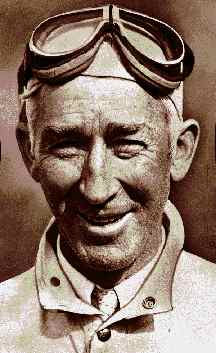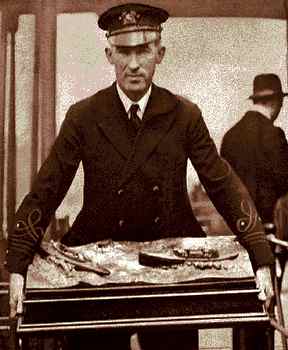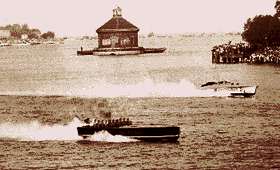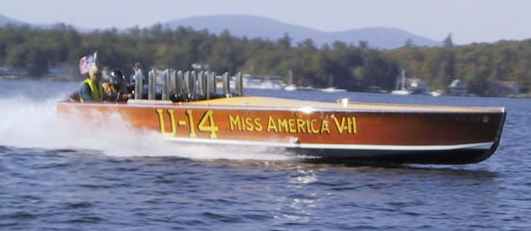|
GARFIELD (GAR) WOOD
|
||||||||||||||||||||||||||||||||||||||||||||||||||||||||||||||||||||||||
|
Wood was only 5 feet 6 and never weighed more than 130 pounds, but he had vision and a huge appetite for speed. He loved airplanes and boats and his marriage of the two would make him the international king of the water in the 1920s and '30s.
Gar Wood, nickname "The Gray Fox"
Without formal education in engineering, Gar Wood, as he was known, was a mechanical genius. He did more than any other American to develop the speedboat and was the first man to go 100 miles an hour on water, and the first to do two miles a minute in a boat.
The Unlimited/Offshore genesis began around 1910. That's when the first "step" hydroplanes appeared. The "fast-steppers" skimmed over the surface of the water with a notch or "step" located approximately amidships on the underside of the hull.
The "step" allowed the boat to plane over the water with much less friction than was possible with the old-style displacement craft. (The latter subscribed to the only known theory of water speed at the time--plowing through the water rather than planing over it.
The "step" hydros were often hard to handle, and they rode like bucking broncos. But they were fast. The "steppers" could run in some of the roughest water imaginable--the ocean, large rivers, or large lakes.
Gar Wood and Christopher Columbus Smith probably did more to refine the "step" hydroplane concept than anyone else. Wood and Smith collaborated on MISS DETROIT III in 1917. They were the first to try a lightweight aircraft engine adapted for marine use in a race boat. The engine in question was a 1650 cubic inch V-4 Curtiss power plant.The experts said it wouldn't work. It had too many delicate parts and would pound to pieces, they said.
Wood built the Gar Jr. II, the world's fastest express cruiser, in 1921. The Gar Jr. II was a V-bottomed displacement boat, in contrast to the hydroplane design of the Miss Americas. A 50-footer with an 11-foot beam, the Gar Jr. II would be adapted by the military as the PT boat of World War II fame.
In a feat that captured the nation's imagination in 1921, Wood raced the Gar Jr. II against the Havana Special train, up the Atlantic coast from Miami to New York. Wood's boat made the 1,250 mile trip in 47 hours and 23 minutes, beating the train by 12 minutes. Four years later, he raced up the Hudson River to beat the famed Twentieth Century Limited in a match race between Albany and New York by 22 minutes.
Wood thought otherwise, figuring that airplane motors would be more dependable than normal boat motors, since there was little margin for engine failure in the air. Accordingly, he bought a Curtiss '12' engine and after rebuilding it, and put it into Miss Detroit III. It worked beautifully and won the 15th Gold Cup Race on the Detroit River. "We hardly ever had to work on it," Wood said.
Working on engines and boats was the joy of Wood's life. He designed many boats, each more powerful than the last. The hydraulic hoist, which helps a boat turn or back up, was the first of Wood's many inventions and patents which helped make him a multi-millionaire by the time he was 40. He was the first man to design a hull strong enough to handle multiple airplane motors and make world-record speeds while remaining maneuverable.
Gar Wood and the Harmsworth Trophy 1920
In 1920, he took his Miss America I speedboat to England to compete for the coveted Harmsworth Trophy, roughly equivalent today to the America's Cup as an international racing spectacle. Wood won. Detroit's downtown streets were jammed from Belle Isle to Randolph as the crowd awaited his return by seaplane. In America, Gar Wood's name had become as famous as Ty Cobb's. Other Miss Americas stood up to challenges from England and France as Wood successfully defended the Harmsworth eight times.
"Miss
America VII" was one in the line of famous "Miss America's"
financed and raced by Gar Wood and designed by Napoleon "Nap"
Lisee. The
original "Miss America" was built by Chris Smith and his sons in
Algonac, Michigan, in the years before they decided turn to pleasure
boating by starting a little company that would come to be called
Chris-Craft.
Gar Wood would break with the Smiths, but Nap Lisee would end up
continuing to work for the industrialist who made his fortune by
inventing the hydraulic dump truck. Lisee is credited with more than 30
of the world's finest race boats, including all 10 "Miss
Americas", all
the "Miss Detroits", all the "Baby Gars", "Baby
Americas" and "Gar Jrs".
The late 1930s witnessed the birth of a radically different concept in competitive power boat designs--the three-point hydroplane, which would forever alter the course of boat racing history. The first successful three-pointers were the product of the famed Ventnor Boat Works of Ventnor, New Jersey. The father and son design team of Adolph and Arno Apel introduced a craft named MISS MANTEO II at the 1936 President's Cup Regatta in Washington, D.C. A 225 Cubic Inch Class competitor, MISS MANTEO II dominated the 225 Class action at Washington and posted speeds that were embarrassingly close to those turned by the larger and more powerful Gold Cup Class hydros.
In 1931, Miss America IX became the first boat to reach 100 mph, topping out at 102.256 mph. That year saw the most dramatic of all the Harmsworth races, with England's Kaye Don the chief opponent, his Miss England II powered by a Rolls-Royce motor from the British Air Ministry.
Miss America IX v Kaye Don 1931
While Wood was a consistent winner, he had occasional setbacks and near-disasters. In August 1928, his Miss America VI blew up on the St. Clair River. His mechanic, Orlin Johnson, was seriously hurt, but eventually recovered. Wood, who always drove his own boats, escaped injury. But he had no boat, and the next race on the Detroit River was in September. So he fished his motors out of 90 feet of water, and redesigned and built a new creation, Miss America VII, in just 14 days. He won the race. Perhaps Wood's greatest design feat was the Miss America X, called a "madman's dream" by engineers. By the time MISS AMERICA X came along in 1932, Wood had upped the ante to four giant engines. These were V-12 Packards, rated at 7600 horsepower, installed two-by-two in a mahogany hull, 38 feet in length. MISS AMERICA X had great difficulty in cornering, but she was the first to average over 124 mph on a mile straightaway course.
The Gar Wood team was never beaten in Harmsworth competition, and retired undefeated after 1933. Their strongest challenger was MISS ENGLAND II in 1931. With Kaye Don driving, MISS ENGLAND II lost the race to MISS AMERICA VIII but posted the fastest lap ever turned on a closed course at 93 miles per hour, a record that would stand unchallenged until 1949.
After his final successful defense with Miss America X in 1933, Wood retired from racing. A wealthy man, he and his wife had homes in Detroit, Algonac, Georgian Bay, Miami and Honolulu, and a son, Gar Wood Jr., to carry on the speedboat racing tradition. He kept up his friendships with members of the Detroit Yacht Club, which he loved, having become its commodore in 1921.
Geoffrey Magnusson's magnificent replica of Miss America VII
One of the biggest names in Offshore history was the late great Don Aronow, who was to ocean racing what Bill Muncey was to Unlimited hydroplane competition. Aronow, a former chief lifeguard at Coney Island, was bored with retirement after fantastic financial success in real estate before he was 35 years old. He turned to the building and racing of Offshore power boats as a new challenge and achieved instant success with his first boat, THE FORMULA.
In 1969, the year of his retirement from racing, Don Aronow received the Union of International Motorboating's Gold Medal, which was personally presented to Don by the "Gray Fox" Gar Wood. Wood had received the same award in 1928.
Wood died at age 90 in Miami in 1971, just a few days before a gigantic civic celebration in his honor was to have been held in Detroit, celebrating the 50th anniversary since his first Harmsworth victory. "If he'd announced at that time that he was going to take off for the moon, his faithful following would have believed him implicitly," wrote George Van for The Detroit News upon Wood's death. "To the public, he was Tom Swift, Jules Verne, Frank Merriwell with a little bit of Horatio Alger thrown in."
APBA GOLD CHALLENGE CUP WINNERS
|
||||||||||||||||||||||||||||||||||||||||||||||||||||||||||||||||||||||||
|
This
website is Copyright © 2013 Bluebird Marine Systems Limited.
The names Bluebird, Solar Navigator™,Blueplanet Ecostar BE3™, Utopia
Tristar™ and the blue bird in flight
|
||||||||||||||||||||||||||||||||||||||||||||||||||||||||||||||||||||||||
|
AUTOMOTIVE | BLUEPLANET BE3 | ELECTRIC CARS | SOLAR CARS | SOLARNAVIGATOR | UTOPIA |
||||||||||||||||||||||||||||||||||||||||||||||||||||||||||||||||||||||||



